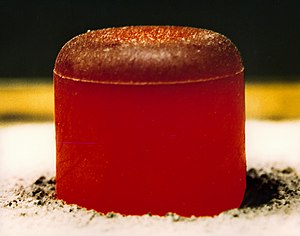Doordat Voyager gebruikmaakt van plutonium als brandstof zal de sonde nog zeker tot 2025 blijven zenden.
Radioisotope thermoelectric generator Last updated 8 days ago
<!-- /firstHeading --><!-- bodyContent --><!-- tagline -->From Wikipedia, the free encyclopedia
<!-- /tagline --><!-- subtitle -->
<!-- /subtitle --><!-- jumpto -->Jump to:
navigation,
search
<!-- /jumpto --><!-- bodycontent -->


Diagram of an RTG used on the
Cassini probe
A
radioisotope thermoelectric generator (
RTG,
RITEG) is an
electrical generator that obtains its power from
radioactive decay. In such a device, the
heat released by the decay of a suitable
radioactive material is converted into
electricity by the
Seebeck effect using an array of
thermocouples.
RTGs have been used as power sources in
satellites,
space probes and unmanned remote facilities, such as a series of
lighthouses built by the former Soviet Union inside the Arctic Circle. RTGs are usually the most desirable power source for
robotic or unmaintained situations needing a few hundred
watts (or less) of power for durations too long for
fuel cells, batteries, or generators to provide economically, and in places where
solar cells are not practical. Safe use of RTGs requires containment of the
radioisotopes long after the productive life of the unit.
<TABLE id=toc class=toc><TBODY><TR><TD>
Contents
</TD></TR></TBODY></TABLE>
History


A pellet of
<SUP>238</SUP>PuO<SUB>2</SUB> to be used in an RTG for either the
Cassini or
Galileo mission. The initial output is 62 watts. The pellet glows because of the heat generated by the radioactive decay (primarily α). Photo is taken after insulating the pellet under a
graphite blanket for several minutes then removing the blanket.
Arthur C. Clarke, in the same brief letter where he introduced the communications satellite, suggested that, with respect to spacecraft, "the operating period might be indefinitely prolonged by the use of thermocouples." <SUP id=cite_ref-0 class=reference>
[1]</SUP><SUP id=cite_ref-1 class=reference>
[2]</SUP>
RTGs were developed in the US in the late 1950s by
Mound Laboratories in
Miamisburg, Ohio under contract with the
United States Atomic Energy Commission. The project was led by Dr. Bertram C. Blanke.<SUP id=cite_ref-2 class=reference>
[3]</SUP>
The first RTG launched in space by the United States was
SNAP 3 in 1961 aboard the Navy
Transit 4A spacecraft. One of the first terrestrial uses of RTGs was in 1966 by the US Navy at uninhabited
Fairway Rock in Alaska. RTGs were used at that site until 1995.
A common application of RTGs is as power sources on spacecraft.
Systems for Nuclear Auxiliary Power (SNAP) units were used especially for probes that travel far enough from the Sun that
solar panels are no longer viable. As such they were used with
Pioneer 10,
Pioneer 11,
Voyager 1,
Voyager 2,
Galileo,
Ulysses,
Cassini,
New Horizons and the
Mars Science Laboratory. In addition, RTGs were used to power the two
Viking landers and for the scientific experiments left on the Moon by the crews of
Apollo 12 through
17 (SNAP 27s). Because the moon landing by
Apollo 13 was aborted, its RTG now rests in the
South Pacific ocean, in the vicinity of the
Tonga Trench.<SUP id=cite_ref-3 class=reference>
[4]</SUP> RTGs were also used for the
Nimbus,
Transit and
LES satellites. By comparison, only a few space vehicles have been launched using full-fledged
nuclear reactors: the Soviet
RORSAT series and the American
SNAP-10A.
In addition to spacecraft, the
Soviet Union constructed many unmanned lighthouses and navigation beacons powered by RTGs.<SUP id=cite_ref-Ref__4-0 class=reference>
[5]</SUP> Powered by
strontium-90 (<SUP>90</SUP>Sr), they are very reliable and provide a steady source of power. Critics<SUP style="WHITE-SPACE: nowrap" class="noprint Inline-Template">[
who?]</SUP> argue that they could cause environmental and security problems as leakage or theft of the radioactive material could pass unnoticed for years, particularly as the locations of some of these lighthouses are no longer known due to poor record keeping. In one instance, the radioactive compartments were opened by a thief.<SUP id=cite_ref-Ref_a_5-0 class=reference>
[6]</SUP> In another case, three woodsmen in
Georgia came across two ceramic RTG heat sources that had been stripped of their shielding; two of the three were later hospitalized with severe radiation burns after carrying the sources on their backs. The units were eventually recovered and isolated.<SUP id=cite_ref-Ref_c_6-0 class=reference>
[7]</SUP>
There are approximately 1,000 such RTGs in Russia. All of them have long exhausted their 10-year engineered life spans. They are likely no longer functional, and may be in need of dismantling. Some of them have become the prey of metal hunters, who strip the RTGs' metal casings, regardless of the risk of radioactive contamination.<SUP id=cite_ref-Ref_d_7-0 class=reference>
[8]</SUP>
The
United States Air Force uses RTGs to power remote sensing stations for
Top-ROCC and
Save-Igloo radar systems predominantly located in
Alaska.<SUP id=cite_ref-Ref_e_8-0 class=reference>
[9]</SUP>
In the past, small "plutonium cells" (very small <SUP>238</SUP>Pu-powered RTGs) were used in implanted
heart pacemakers to ensure a very long "battery life". <SUP id=cite_ref-Ref_f_9-0 class=reference>
[10]</SUP> As of 2004<SUP style="DISPLAY: none" class="plainlinks noprint asof-tag update">
[update]</SUP>, about 90 were still in use.





